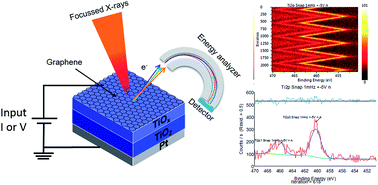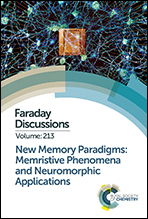Chemically addressed switching measurements in graphene electrode memristive devices using in situ XPS
Abstract
The memristor has been the topic of heated research activity since the Pt/TiO2/TiOx/Pt structure was reported by Hewlett-Packard Labs. The characteristics of memristors such as the pinched hysteresis loops and time and input signal-dependent memristance are due to the drift of positively charged oxygen vacancies in the TiOx layer. While different modes of switching behaviour have been characterized, observing the switching as it happens with in situ measurements using X-ray photoelectron spectroscopy (XPS) can allow a better understanding of the device operation. The setup used in this work enables the application of voltage signals of different frequencies and amplitudes and observing the hysteresis seen in the I–V plane through chemical addressing. The measurements were conducted on Pt/TiO2/TiOx/graphene structures. The single layer graphene, utilized as a top electrode, effectively acts as a transparent electrode in that the layer beneath it can be observed to a depth of ∼10 nm in XPS. This allows for the observation of the changes in the binding energies of C 1s, Ti 2p and O 1s. By comparing the variation in the binding energy of Ti 2p to that of C 1s, and observing how the variation changes for different excitation signals (at different frequency and amplitudes), it is possible to inspect the effect of the oxygen vacancy drift. We employed a variety of input signals with varying frequency and amplitudes in order to test the memristive devices thoroughly: sine wave, triangular wave and DC bias. Graphene has been attracting attention due to its intriguing optoelectronic properties. This study utilizes graphene as a transparent top electrode for in situ measurements in XPS to observe chemically-addressed memristive hysteresis while an excitation signal is being applied to the device.

- This article is part of the themed collection: New memory paradigms: memristive phenomena and neuromorphic applications


 Please wait while we load your content...
Please wait while we load your content...